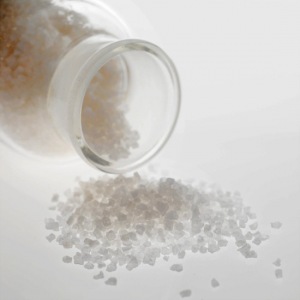Tag Archives: zombie
ZOMBIE OUTBREAK? – Are Zombie Bees Infiltrating Your Neighborhood?
Parasite zombie flies and a honeybee; courtesy of John Hafernik/SF State University
Zombie bees are not science fiction. They are real—and real threat to already-threatened U.S. honeybee populations.
Honeybees (Apis mellifera) in California and South Dakota have been observed acting zombielike, wandering away from their hives at night and crawling around blindly in circles.
These insects have been rendered insensate by a parasitizing fly that lays eggs in the bees’ bodies. After the bee dies a lonesome death, pupae crawl out and grow to adult flies that seek new bodies to infect.
Such a sight startled John Hafernik, a professor of biology at San Francisco State University, when he looked at dead honey bees he had collected on campus. He soon started noticing clumps of dead bees under light fixtures in the area. He and his colleagues found that this bizarre bee behavior was the result of the fly Apocephalus borealis (they described their findings in January in the journal PLoS ONE). After sampling hives around the Bay Area, they found that, disturbingly, more than three quarters were infected with this parasite.
Honeybee colonies have been collapsing at an alarming rate in the U.S. for the past several years. And without these important pollinators, many of our favorite foods, from almonds to zucchini would be difficult to produce. Scientists have implicated viruses, fungi, mites and other invaders in colony collapse disorder, but Hafernik suspects this parasite is a new villain on the scene. “Honeybees are among the best-studied insects,” he said in a prepared statement in January. “We would expect that if this has been a long-term parasite of honeybees, we would have noticed.”
How do you catch a zombie bee? A “ZomBee” trap; courtesy of John Hafernik/SF State University
Now, to see how far the zombified bee problem has spread, he and his colleagues are enlisting the help of the whole continent. They have launched ZomBeeWatch.org, a citizen science project that allows people to help them track suspicious bee behavior and collect specimens. Through the project, which launches in full today, they are hoping to find “if this parasitism is distributed widely across North America,” Hafernik said in a new statement.
To help out, you can sign up to collect sick-looking or dead bee specimens and observe them to see if parasite fly pupae emerge. Industrious citizen scientists can build light traps to attract any parasitized bees in their area (full instructions are on their site). And the researchers promise that even bees that do not turn out to be true “ZomBees” are important to report in an effort to better understand contributors to colony collapse.
“If we can enlist a dedicated group of citizen scientists to help us, together we can answer important questions and help honeybees at the same time,” Hafernik said.
Not sure what a zombie bee looks like? Here’s a video clip of a sick bee: http://www.youtube.com/watch?v=xs32DCaxU1U&feature=youtu.be (Read more about parasites that make their hosts act like zombies in the article “Zombie Creatures.”)
In case you’re wondering what we’ve been wondering—ahem, what else can these zombie flies infect?—ZomBee Watch has an answer: “The zombie fly only parasitizes insects and does not lay eggs on or in humans,” according to its website. “As far as we know, it does not transmit any diseases that are contractible by humans.” As far as we know…
The Walking Dead: Love Will Continue To Blossom For Maggie & Glenn

SAN DIEGO, CALIF. — “The Walking Dead” survivors may be gearing up for another battle with zombies in Season 3, but it looks like love will continue to blossom for Maggie and Glenn.
“I think where we are going to pick [back up] is two people, living with an entire group, where the key is survival and survival means needing the person next to you,” Steven Yeun, who plays Glenn told AccessHollywood.com at Hyundai Undead: “The Walking Dead” 100th issue release party at Petco Park at Comic-Con 2012. “And, if you have someone you love, needing them even more, and I think the bond only gets stronger.”
WATCH: Norman Reedus Interview — The Walking Dead Season 3 Is ‘Full Of Rage’
Lauren Cohan, who plays former farm resident Maggie, thinks her character has found “the one” in Glenn.
“I think Maggie and Glenn have definitely been looking for their kindred one and their kindred spirit and I think they both have this kind of pure, optimistic, hopeful thing,” she said of the characters’ love in the show’s crazy world. “And when you find that in someone else, you’re not going to let it go, especially when there’s nine of you and four of them are your relatives.”
But with the coming of one of new villain — The Governor (David Morrissey) – and the world filled with plenty of survivors hoping to do the gang harm, that love could be used as a tool to manipulate the other party.
“Absolutely. There is weakness in that as well, which is exactly — leverage,” Steven told Access. “I’m sure that’ll be tested, but I can’t say [any more].”
WATCH: David Morrissey Talks Joining The Walking Dead Season 3 As The Governor
Currently halfway through shooting Season 3, the cast are still amazed at how big their show has grown.
“It was crazy, it was craziness,” Steven said of their Season 2 ratings, which reached 8 million. “To think about what you do in an isolated area of Atlanta, and you just come together and put makeup on and pretend. And to have that many people watch it and enjoy it and continue to watch it and support you? That’s an overwhelming feeling. I can’t even qualify it really. It’s pretty great.”
“The Walking Dead” returns October 14 at 9/8c on AMC.
5 Things to Know About Zombies
 The Bridgewater Township Library is holding its Zombie Party Thursday at 6 p.m. for grades six through 12, as everyone will be invited to see if they have what it takes to survive the Zombie Apocalypse. The party will include Zombie Trivia, Humans vs. Zombies tag and much more. So in honor of this exciting evening, we present five things to know about zombies.
The Bridgewater Township Library is holding its Zombie Party Thursday at 6 p.m. for grades six through 12, as everyone will be invited to see if they have what it takes to survive the Zombie Apocalypse. The party will include Zombie Trivia, Humans vs. Zombies tag and much more. So in honor of this exciting evening, we present five things to know about zombies.
Information from trivology.com.
- Completely Undead—Zombies are fictional characters that are brought back to life after death. Once back, they are said to feed on human flesh. They come back to life through some kind of magic.
- Programmed Robot—Supposedly, zombies are not conscious of having been brought back to life, and they act like robots with no other objectives.
- Long Popularity—Zombies have been popular in European and American cinema since the 19th century.
- Really Scary—Zombies are considered to be very scary villians in cinema because they are not afraid of anything. They also tend to pop up randomly in films, frightening those around them.
- Spread by Bite—Normally in films, if a zombie bites another human just once, that person will become a zombie too.








